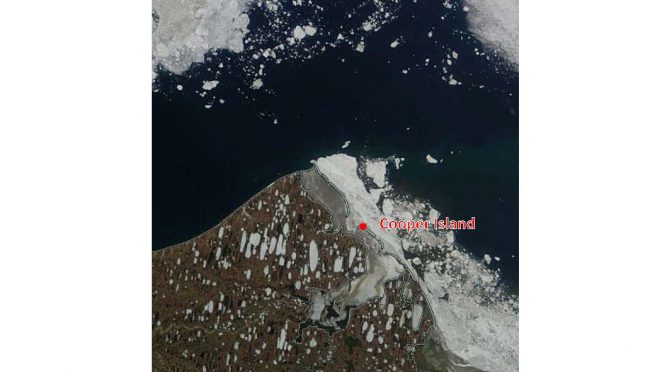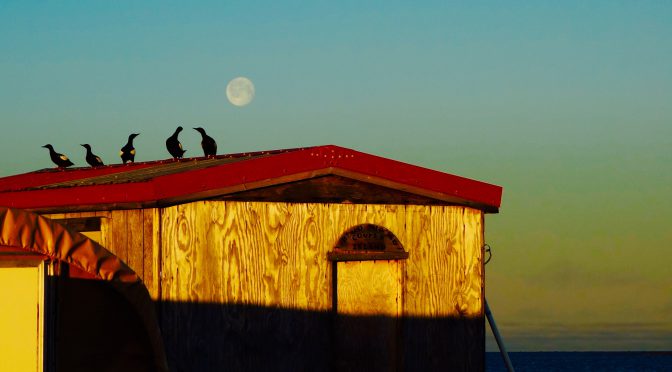Polar bears caused me to get a cabin on Cooper Island in 2003. After a rapid retreat of sea ice in August 2002, bears trashed our tents, which required making a hasty departure from the island with the help of a North Slope Borough Search and Rescue helicopter. The first week of the 2019 field season found me again living in a tent as I cleaned up after a polar bear was able to remove the board covering the cabin door and rearrange much of the gear and supplies I store on the island overwinter. Damage was not major but making my...

Start of the 45th field season
Even after 44 years, preparing for the field season to study Black Guillemots on Cooper Island is a time of excitement and anticipation as I gather the gear and supplies needed to survive and conduct research for three months on a remote Arctic island. This year the excitement was tempered with a high level of anxiety given last summer’s disastrous breeding season. While the size of the colony has been decreasing since the 1990s, as the guillemots’ sea ice habitat has steadily dwindled, the 2018 breeding season was unique in that 1) the overwinter mortality of breeding birds was three...
2019 Seattle Update – March 26
Tuesday March 26 at Seattle’s Swedish Club Reception at 6 pm with presentation at 7 pm Reception at 6 pm with talk at 7 pm The Cooper Island Black Guillemot colony was first recognized as a monitor of a warming climate in 2002, the 23rd year of the study. Decreasing sea ice in a rapidly melting Arctic continues to diminish its population and breeding success. Now in its 44th year, and with evidence of global climate change increasingly evident, our research is documenting this Arctic seabird’s struggle to survive. Join us to hear about the current status of this unique Arctic seabird – our canary in...
2018 Arctic Report Card and AGU Annual Meeting
For 13 years NOAA has released an annual “Arctic Report Card“. That NOAA feels the need to issue a report on the an annual basis reflects the rapid pace of change occurring in the region. As in past years the 2018 Arctic Report Card was released at the Annual Meeting of the American Geophysical Union (AGU), this year occurring on 9-14 December in Washington D.C. The reports provide a concise annual summary of major physical and biological changes documented in the Arctic over the past year and also serve to focus the media and public on the larger issue of global...
44th Cooper Island field season comes to an end
End of season field report by George Divoky. For the past four decades, my field seasons on Cooper Island studying Black Guillemots have always begun with high spirits and a feeling of optimism. Experiencing the 24 hours of daylight in early June while documenting the return of individual birds to the island and their nest sites is always uplifting – some of these seabirds have been returning to Cooper Island for decades. Then, the days begin to shorten as nighttime returns to the Arctic. After monitoring the colony’s breeding activity for over three months, the end of the field season...
The first chick of 2018 has fledged from Cooper Island!
In a breeding season and field season that has been a tough one for both the Black Guillemots on Cooper Island and the investigators studying them, today was a day of celebration as morning nest checks revealed that the oldest nestling on the island had departed for the sea during the night. The first fledge of the year is always exciting since it is an important benchmark in our field season, which begins with recording the owners of nest sites and continues with observing the dates of egg laying and monitoring the hatching and subsequent growth of nestlings. While it...
Uncertain Future for Nestlings: Sea ice retreat shifts prey out of foraging range
George’s latest field report describes his daily nest checks as parents are feeding chicks to prepare them for fledging. Black Guillemots have their young remain in the nest for almost five weeks, being nearly adult weight and independent of the parents when fledging. Returning to the nest with a single fish in their bill is a breeding strategy found in all member of the genus Cepphus; it reflects the abundance and predictability of prey in the nearshore waters where parents forage while provisioning young. For guillemots breeding in subarctic and temperate areas, where the nearshore provides a diverse and ample supply...
Long-term Data Collection Serves Many: Cooper Island study aids graduate students studying climate change
Graduate student Drew Sauve recently returned from Cooper Island. He describes his collaboration with George in this guest post. The Black Guillemots on Cooper Island are one of many wild populations that are responding to climate change by changing when they lay their eggs. These Arctic seabirds want to lay their eggs as soon as the winter snow melts and spring begins, because their breeding season—from first access to a nest cavity to departure of chicks—is 80 days, an exceptionally long breeding period for a bird. Parent guillemots have to have their young ready to fly off to sea before...
Hatched! So far, so good for the 2018 chicks on Cooper Island
August 11, 2018: Field report Hatching is finally over with one very late egg hatching today after having been incubated for 34 days; 28 days is normal. The oldest nestling is 16 days old; the chick is gaining weight and doing well like all of the other 45 nestlings. While the main pack ice is well offshore, the Marginal Ice Zone, where ice covers from 18 to 80 percent of the ocean’s surface, extends south to the entire Alaskan Beaufort Sea coast, including Cooper Island. The seascape visible from the north beach now has widely scattered floes, some with rather...
First chicks of the 2018 season
August is the rainy month of our field season, and the first day of the month was tough for us. During our morning nest checks, it wasn’t easy to keep our hands warm in a steady soaking rain, coupled with a windchill of 27 degrees Fahrenheit. The fingerless gloves I wear daily in the summer are a godsend for handling eggs and nestlings–wet fingerless gloves at temperatures near freezing are only slightly better than no gloves at all. The cold, wind and rain (and numb fingers) were made more bearable by the fact that our nest checks found hatching high...
